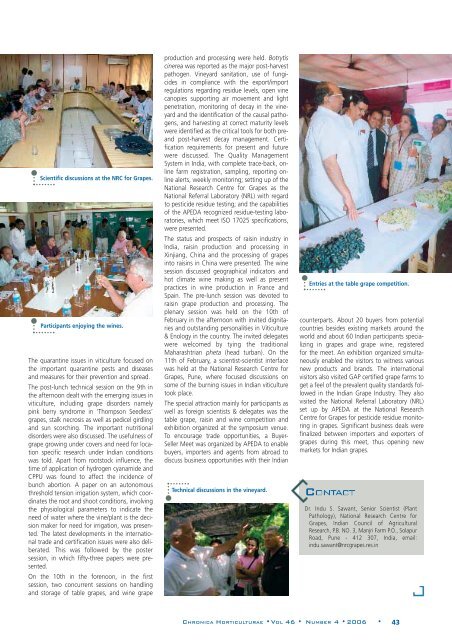Chronica - Acta Horticulturae
Chronica - Acta Horticulturae
Chronica - Acta Horticulturae
You also want an ePaper? Increase the reach of your titles
YUMPU automatically turns print PDFs into web optimized ePapers that Google loves.
Scientific discussions at the NRC for Grapes.<br />
Participants enjoying the wines.<br />
The quarantine issues in viticulture focused on<br />
the important quarantine pests and diseases<br />
and measures for their prevention and spread.<br />
The post-lunch technical session on the 9th in<br />
the afternoon dealt with the emerging issues in<br />
viticulture, including grape disorders namely<br />
pink berry syndrome in ‘Thompson Seedless’<br />
grapes, stalk necrosis as well as pedicel girdling<br />
and sun scorching. The important nutritional<br />
disorders were also discussed. The usefulness of<br />
grape growing under covers and need for location<br />
specific research under Indian conditions<br />
was told. Apart from rootstock influence, the<br />
time of application of hydrogen cyanamide and<br />
CPPU was found to affect the incidence of<br />
bunch abortion. A paper on an autonomous<br />
threshold tension irrigation system, which coordinates<br />
the root and shoot conditions, involving<br />
the physiological parameters to indicate the<br />
need of water where the vine/plant is the decision<br />
maker for need for irrigation, was presented.<br />
The latest developments in the international<br />
trade and certification issues were also deliberated.<br />
This was followed by the poster<br />
session, in which fifty-three papers were presented.<br />
On the 10th in the forenoon, in the first<br />
session, two concurrent sessions on handling<br />
and storage of table grapes, and wine grape<br />
production and processing were held. Botrytis<br />
cinerea was reported as the major post-harvest<br />
pathogen. Vineyard sanitation, use of fungicides<br />
in compliance with the export/import<br />
regulations regarding residue levels, open vine<br />
canopies supporting air movement and light<br />
penetration, monitoring of decay in the vineyard<br />
and the identification of the causal pathogens,<br />
and harvesting at correct maturity levels<br />
were identified as the critical tools for both preand<br />
post-harvest decay management. Certification<br />
requirements for present and future<br />
were discussed. The Quality Management<br />
System in India, with complete trace-back, online<br />
farm registration, sampling, reporting online<br />
alerts, weekly monitoring; setting up of the<br />
National Research Centre for Grapes as the<br />
National Referral Laboratory (NRL) with regard<br />
to pesticide residue testing; and the capabilities<br />
of the APEDA recognized residue-testing laboratories,<br />
which meet ISO 17025 specifications,<br />
were presented.<br />
The status and prospects of raisin industry in<br />
India, raisin production and processing in<br />
Xinjiang, China and the processing of grapes<br />
into raisins in China were presented. The wine<br />
session discussed geographical indicators and<br />
hot climate wine making as well as present<br />
practices in wine production in France and<br />
Spain. The pre-lunch session was devoted to<br />
raisin grape production and processing. The<br />
plenary session was held on the 10th of<br />
February in the afternoon with invited dignitaries<br />
and outstanding personalities in Viticulture<br />
& Enology in the country. The invited delegates<br />
were welcomed by tying the traditional<br />
Maharashtrian pheta (head turban). On the<br />
11th of February, a scientist-scientist interface<br />
was held at the National Research Centre for<br />
Grapes, Pune, where focused discussions on<br />
some of the burning issues in Indian viticulture<br />
took place.<br />
The special attraction mainly for participants as<br />
well as foreign scientists & delegates was the<br />
table grape, raisin and wine competition and<br />
exhibition organized at the symposium venue.<br />
To encourage trade opportunities, a Buyer-<br />
Seller Meet was organized by APEDA to enable<br />
buyers, importers and agents from abroad to<br />
discuss business opportunities with their Indian<br />
Technical discussions in the vineyard.<br />
Entries at the table grape competition.<br />
counterparts. About 20 buyers from potential<br />
countries besides existing markets around the<br />
world and about 60 Indian participants specializing<br />
in grapes and grape wine, registered<br />
for the meet. An exhibition organized simultaneously<br />
enabled the visitors to witness various<br />
new products and brands. The international<br />
visitors also visited GAP certified grape farms to<br />
get a feel of the prevalent quality standards followed<br />
in the Indian Grape Industry. They also<br />
visited the National Referral Laboratory (NRL)<br />
set up by APEDA at the National Research<br />
Centre for Grapes for pesticide residue monitoring<br />
in grapes. Significant business deals were<br />
finalized between importers and exporters of<br />
grapes during this meet, thus opening new<br />
markets for Indian grapes.<br />
CONTACT<br />
Dr. Indu S. Sawant, Senior Scientist (Plant<br />
Pathology), National Research Centre for<br />
Grapes, Indian Council of Agricultural<br />
Research, P.B. NO. 3, Manjri Farm P.O., Solapur<br />
Road, Pune - 412 307, India, email:<br />
indu.sawant@nrcgrapes.res.in<br />
CHRONICA HORTICULTURAE •VOL 46 • NUMBER 4 • 2006 • 43
















